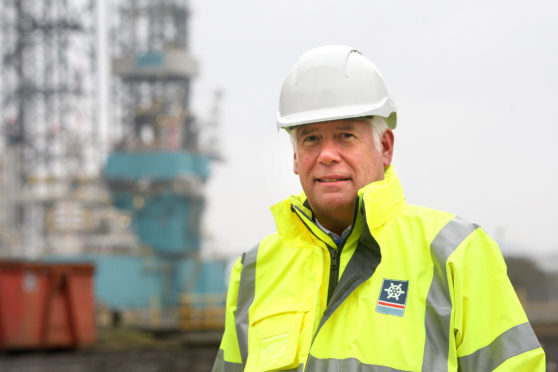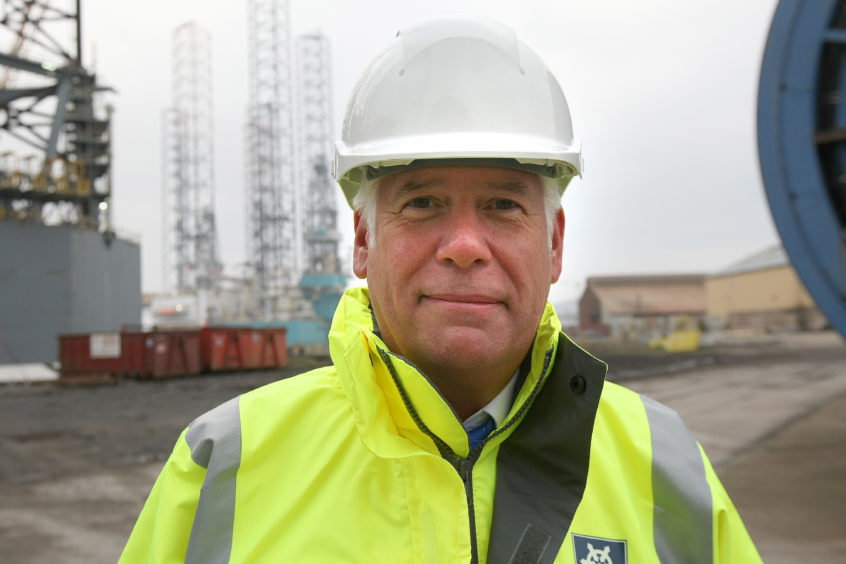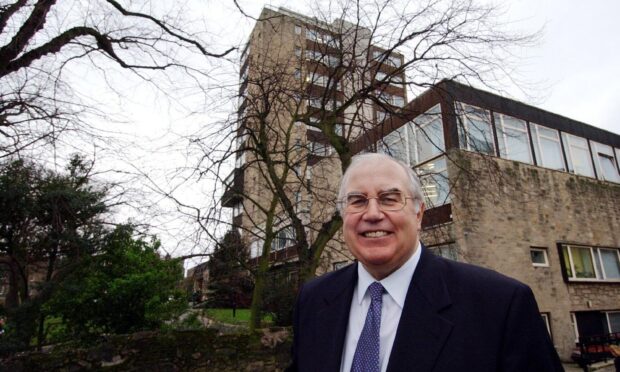The man leading Dundee’s bid to be a decommissioning hub has blasted a decision to develop ultra deep facilities at a rival port, claiming the bill for taxpayers could reach £100 million.
The Scottish Government, backed by the Oil and Gas Authority (OGA), has selected Dales Voe in Shetland ahead of Dundee as the preferred location for the UK’s first ultra deep water port for large-scale decom work.
Still furious at the decision a month on, Calum Falconer of Dundeecom said the move “flew in the face of impartiality, objectiveness and fair competition”.
And he claimed the “handout” from taxpayers to fund the development would “likely be in the region of £100 million”.
The Scottish Government has hit back, saying this was not a figure it recognised in any “present or past Scottish Government decommissioning policy”.
Mr Falconer said last month’s decision made no more sense now the dust had settled on it.
“At best, this whole issue is in serious commercial conflict, and at worst a non-transparent, politically-stimulated knee-jerk that, from an economic perspective, is likely to be a car crash of Holyrood-esque proportions in its return to the taxpayer,” he said.
See below for full commentaries by Dundeecom chief executive Callum Falconer and Oil and Gas Authority director Stuart Payne, and a response from Energy Minister Paul Wheelhouse
And he insisted Dundee had a “superior quayside, similar water depth and channel access, and far better logistical infrastructure”.
Mr Falconer said he felt the UK decommissioning supply chain would “right size and right skill itself when the time is right for investment, on the back of successful contracts” but it needed impartial support from Government and regulators.
“Above all, politicians and regulators need to stop using decommissioning as a cheap political points-scoring weapon,” he said.
Energy minister Paul Wheelhouse said the Scottish Government would shortly publish the “independent and impartial” feasibility study carried out by EY which identified Dales Voe as the preferred site.
And he noted that Dundee had received considerable support from the Government’s Decommissioning Challenge Fund.
This has included £582,010 to Oilfield Machinery to enable it to place a heavy lift crane at the Port of Dundee.
Mr Wheelhouse said: “The study examines how to best access a market for decommissioning the largest offshore structures – that the UK cannot currently provide a solution for – in order to compete with European and further afield ultra-deep water ports.
“If Scotland and the wider UK does not progress an ultra deep water facility, then considerable project value will be lost to both the Scottish and UK supply chains.
“That would be to the detriment of Dundee and other ports.”
He said the report considered the physical characteristics of port locations required to accommodate a water depth of 24 meters and deemed Dundee unsuitable.
“It demonstrated that Dundee cannot accommodate these ‘heavy lift’ decommissioning vessels and that Dales Voe in Shetland was a clear frontrunner for such a facility,” Mr Wheelhouse said.
He added: “The same opportunities for decommissioning in Dundee that present today will remain even with the creation of an ultra deep water facility”.
Investment in ultra deep facility needed to compete with Norway
An Oil and Gas Authority director has said the move to create an ultra deep water facility in Scotland is essential to compete with Norway for decommissioning work.
Stuart Payne, director of HR and supply chain, said developing the Dales Voe port in Shetland for ultra deep vessels would help capitalise on the North Sea decom opportunity.
He said: “In recent years, we’ve seen a number of sizeable platform removal and disposal contracts awarded overseas to places like Norway, where there’s also a first-class supply chain.
“The UK needs to be able to demonstrate it can compete against not just the Norwegian suppliers, but suppliers from all over the world.
“There is a real race underway to build up capability and take the market share.”
Dundeecom is already working to establish a partnership with Norwegian operator AF Gruppen in the hope of establishing a decom base in Dundee.
The government agency’s latest estimate put the projected cost of decommissioning the North Sea’s facilities at £58 billion.
Mr Payne said he expected Dundee to play a “key part” in future decom work.
“We know there may have been disappointment around a recent Scottish Government announcement identifying Dales Voe in Shetland as their preferred location for a possible ultra-deep water port,” he added.
“But we should recognise that an ultra-deep water port is only one specific type, and having one doesn’t mean we have solved the decommissioning challenge – far from it.
“Given the scale and diversity of the UK’s decommissioning challenge and the numbers of platforms, wells and infrastructure we’re talking about, it’s clear that what the UK needs to prevent this work going overseas is a selection of different ports with varying capabilities and a skilled, capable supply chain.
“I fully expect Dundee to be a key part of that future.”
COMMENT — by Callum Falconer – chief executive, Dundeecom
The City of Dundee is currently recovering from port-industrial depression, with help from the open-minded council (including an overdue Tay Cities Deal), and local philanthropists.
The green shoots of optimism are clear, demonstrated not least by the emerging waterfront development complete with the shining light that is the V&A Museum.
Social issues however still prevail, with unemployment around 32%, twice the UK average.
Integral to the Tay Cities Deal, Dundeecom was formed and has been active these last 18 months in exploring the entrepreneurial spirit of Forth Ports and others in creating a decommissioning hub in the region.
To date, Well-Safe Solutions have selected the Port of Dundee as their base while Chinese Ocean Engineering Shanghai Co (COES), following a rigorous appraisal of Scottish Ports, have also selected Dundee as their optimal location and will open a project office in the city later this year.
We have also been facilitating an agreement between Port of Dundee and Norwegian decommissioning giants AF Offshore UK and expect this to be signed in due course.
This will in turn undoubtedly stimulate further activity and investment in the city in the short term.
Port of Dundee for its part has invested £10m of private money in building the strongest and longest quayside in the UK which has prompted Augean North Sea Services and Oilmac Heavy Lifting to create an unprecedented decommissioning supply chain within the port boundary and further investment by Forth Ports is imminent.
Meanwhile, flying in the face of impartiality, objectiveness and fair competition, the Scottish Government along with the Oil and Gas Authority are advocating Dales Voe in Shetland as the go-to facility for decommissioning. Why?
There is no context, there is not a UK national port strategy in place today.
The vast majority of UK ports are privately owned and financed. The UK Government has to date supported this and has until now not interfered in this market place.
Publicly owned ports require public funds to support investment and therefore need to be creative in their investment plans to attract public sector borrowing.
But all of this is now out of the window.
Shetland, beneficiary of decades of taxes from the Sullom Voe oil terminal and the recent Total gas plant, and with the lowest unemployment in the UK (0.5%) will now get a hand-out from the tax-payer for an Ultra-Deep-Water Port, likely to be in the region of £100 million.
And just to underline the importance of this decision (and presumably the relative unimportance of the rest of the Scottish ports trying their best to compete for business) the OGA recently took all and sundry to Shetland for a knees-up to celebrate.
Astonishingly, this decision was based on a top-secret report commissioned from consultancy firm EY, the six-figure bill paid for with tax-payers’ cash, and where to my knowledge no Scottish port was consulted.
The reason for the selection of Dales Voe over competing ports (and I would put Dundee very much in this bracket, due to its superior quayside, similar water depth and channel access, and far better logistical infrastructure) will probably never be known. What’s more, EY has also been selected by BEIS for a further study into a UDWP; so much for healthy competition and second opinions!
At best, this whole issue is in serious commercial conflict, and at worst a non-transparent, politically-stimulated knee-jerk that, from an economic perspective, is likely to be a car crash of Holyrood-esque proportions in its return to the tax-payer, and one that casts a dark shadow on the role of the OGA and to me is in complete counterpoint to the MER initiative.
It is my firm opinion that the UK decommissioning supply chain will right-size and right-skill itself when the time is right for investment, on the back of successful contracts.
Like other industries in UK history (shipbuilding being a good example) it will shape its own future from current immaturity to world-leading status; but it needs impartial support from government and regulators to achieve this.
Above all, politicians and regulators need to stop using decommissioning as a cheap political points-scoring weapon.
COMMENT — by Stuart Payne, director of HR and Supply Chain, Oil and Gas Authority
Over the course of the next few decades, hundreds of UK oil and gas platforms, thousands of wells and millions of tonnes of infrastructure will need to be safely and efficiently decommissioned when they reach the end of their productive life.
The scale of opportunity is vast – the OGA’s latest estimate put the projected cost of decommissioning the North Sea’s facilities at £58 billion.
Decommissioning is much more than simply cutting the legs off a platform and sending it off on a barge to the shore.
In fact, this is not the most expensive part of decommissioning.
There’s a whole industry that involves project management, logistics, managing waste and recycling materials as well as safely plugging and abandoning subsea wells (by far the most expensive part of most decom plans).
Whilst our primary responsibility in decommissioning is to assess proposals on the basis of cost, and consider future alternative use and collaboration, we believe that we have a role to play, with others, in helping promote the considerable opportunity for a homegrown UK decommissioning industry.
The OGA believes that the opportunity exists, right across the supply chain, for UK firms and facilities to compete for this valuable and long-term work and to build expertise and capability.
In recent years, we’ve seen a number of sizeable platform removal and disposal contracts awarded overseas to places like Norway, where there’s also a first-class supply chain.
The UK needs to be able to demonstrate it can compete against not just against not just the Norwegian suppliers, but suppliers from all over the world, where there is a real race underway to build up capability and take the market share.
The UK’s needs as a customer of decommissioning are diverse – with a wide range of different types of facilities, infrastructure and pipelines that will need to be dealt with safely and economically.
The UK’s strength as a provider of decommissioning therefore is that we can match this diverse demand with a broad range of services and skills.
We know there may have been disappointment around a recent Scottish Government announcement to identify Dales Voe in Shetland as their preferred location for a possible ultra-deep water port, but we should recognise that an ultra deep water port is only one specific type, and having one doesn’t mean we have solved the decommissioning challenge – far from it.
Given the scale and diversity of the UK’s decommissioning challenge and the numbers of platforms, wells and infrastructure we’re talking about; it’s clear that what the UK needs to prevent this work going overseas, is a selection of different ports with varying capabilities and a skilled, capable supply chain. I fully expect Dundee to be a key part of that future.
Which is why all parties – governments, ports, trade associations and supply chain need – to work together to realise the value of this opportunity.
The OGA’s role in support of the supply chain includes the introduction this year of Supply Chain Action Plans aimed at supporting quality project delivery and supplier engagement for all major new projects, including decommissioning.
The OGA also maintains Project Pathfinder, a tool which allows suppliers to see upcoming work-scopes and prepare themselves to bid for them and I am one of the two Co-Chairs of the MER UK Supply Chain & Exports Taskforce which brings together UK Government Departments like BEIS & DIT, the Scottish Government, Scottish Enterprise and all of the major trade associations in our sector – representing the whole of the UK.
In all of this activity, supporting industry, we are focused on the opportunities offered by Vision 2035 – a bold ambition to add 3 billion barrels of production and to double UK’s share of world exports within the next 17 years.
By achieving these goals, working together, collaborating, innovating and learning as an industry, we have the potential to generate up to £900 billion for the UK economy and sustain investment, jobs and skills for the next generation.
COMMENT — by Energy Minister Paul Wheelhouse
The creation of an ultra-deep water port in Shetland presents an opportunity for Dundee as it could serve to benefit the Scotland-wide decommissioning network, bringing more decommissioning work to ports across the country, including Dundee which itself has itself received considerable support from our Decommissioning Challenge Fund (DCF) to enhance its capabilities.
This year the Scottish Government has already provided £582,010 alone from the DCF to Oilfield Machinery enabling them to place their heavy lift crane on Dundee’s newly strengthened quayside, as well as a number of projects within the wider Tay region.
The Scottish Government will, as indicated last month, shortly publish the independent and impartial feasibility study carried out by EY.
The study examines how to best access a market for decommissioning the largest offshore structures – that the UK cannot currently provide a solution for – in order to compete with European and further afield ultra-deep water ports.
If Scotland and the wider UK does not progress a ultra deep water facility, then considerable project value will be lost to both the Scottish and UK supply chains. That would be to the detriment of Dundee and other ports.
The report also considers the physical characteristics of port locations required to accommodate decommissioning vessels that require a water depth of 24 meters to operate.
It demonstrated that Dundee cannot accommodate these heavy lift decommissioning vessels and that Dales Voe in Shetland was a clear frontrunner for such a facility for reasons the EY study makes clear.
The characterisation of the work undertaken by EY is therefore unfair and unhelpful.
The same opportunities for decommissioning in Dundee that present today will remain even with the creation of an ultra-deep water facility, and I very much look forward to hearing how Dundee plan to access these.













